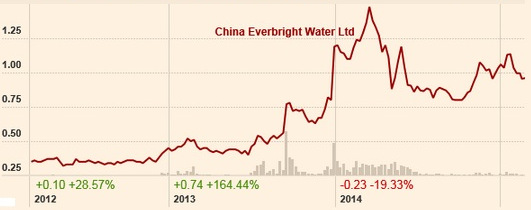|
Future growth
 Vice-Chairman & CEO Wang Tianyi: China Everbright Water seeks to be among the top water players in China. Photo by Sim Kih6. Given its strong balance sheet, Everbright Water is actively seeking acquisition targets. Vice-Chairman & CEO Wang Tianyi: China Everbright Water seeks to be among the top water players in China. Photo by Sim Kih6. Given its strong balance sheet, Everbright Water is actively seeking acquisition targets.
The opportunities abound because the water treatment industry in China is highly fragmented and about 50% of the treatment capacity is owned by municipal governments which could be privatised.
7. In the near-term, Everbright Water will also expand the capacity of, and upgrade, the existing water treatment plants of HanKore which are of 1B grade. Most of the plants from Everbright’s side are operating at full capacity with Grade 1A discharging standard.
8. The Chinese government, in its 5-year plan, had budgeted RMB430 billion for the water treatment industry and has spent only about half so far. This year is the final year of the 5-year period and is expected to see the government accelerate its investment in the industry.
 China Everbright Water (stock price: 96 cents) has a market cap of S$2.38 billion. China Everbright Water (stock price: 96 cents) has a market cap of S$2.38 billion.
Chart: FT.com
CEO Wang Tianyi said at the briefing that pollution of drinking water is a serious problem in China.
About 60% of underground water reserves, the main source of drinking water, have been found to be unsafe for human consumption. The problem is even worse for surface water, which is up to 70% contaminated.
This means a lot of investment will be poured into facilities to ensure the quality of drinking water -- and this could be a new business segment for China Everbright Water.
The latest government discussion that took place at the end of year 2014 yielded conclusions that the government should focus on the safety of drinking water.
The latest amendment to the Environmental Protection Act took effect from 1 January 2015, imposing stricter standards and higher penalties.
As the legislation was last amended 14 years ago, this means many new regulations were introduced.
Mr Wang also explained the new Public-Private Partnership (PPP) model for water treatment infrastructure. Advantages of the model:
> Leverage on private partners for financing
> Improves project operational efficiency
> Builds on existing Build-Operate-Transfer and Transfer-Operate-Transfer models
This PPP model, coupled with the upcoming Action Plan for the prevention of water pollution, are expected to result in trillions of dollars of investment in the next few years. They will be the golden era of the water industry.
The government wants to ensure that service providers to stay profitable but will not allow them to be excessively lucrative.
|
 NextInsight
a hub for serious investors
NextInsight
a hub for serious investors








